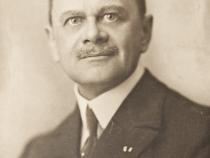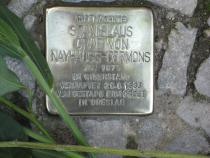Location
Stierstr. 4
District
Friedenau
Stone was laid
21 September 2009
Born
07 May 1875 in Baumgarten (Schlesien) / Braszowice
Occupation
Offizier
Death due to incarceration and torture
26 June 1933 in Breslau
In the last years of the Weimar Republic, Stanislaus Graf von Nayhauss-Cormons actively opposed the Nazis with his writings. He was therefore in immediate danger when the Nazis came to power in 1933.
He was born on 7 May 1875 in Schloss Baumgarten (now Braszowice), the seventh child of an aristocratic Catholic family based in Silesia. His father was a retired cavalry captain and had been a member of the Reichstag and the Prussian parliament for the Catholic Centre Party. Untypically for his class, Stanislaus’ parents sent him to the local primary school. But his subsequent education followed the classic course. After grammar school, he attended cadet school, first in Potsdam and, from the age of sixteen, the central cadet school in Berlin-Lichterfelde, where he was trained for an officer’s career. Later he served in the cavalry in various units and at different garrisons and also earned a reputation as a steeplechase jockey. Having reached the rank of cavalry captain, he retired from service in 1912 at the age of 37 and began working in industry.
When the First World War broke out, Graf Nayhauss-Cormons returned to service as a cavalry captain in the 13th Königs-Ulanen Regiment in Hanover but soon afterwards sustained a serious riding injury. To recover, he took a health cure at Lake Constance but this led to a misunderstanding which turned into a nightmare. In 1915, he was condemned to death for high treason and was held for years, an innocent man, in a prison cell. He was finally rehabilitated in 1919 and recorded his experiences in a book published in 1929 titled “Unschuldig zum Tode verurteilt. Lebens-Erinnerungen eines deutschen Reiteroffiziers” (‘Condemned to death when innocent. Memoirs of a German cavalry officer’).
On his release Nayhauss-Cormons worked in business. In the 1920s, he began writing political articles. Himself a German nationalist, he was nevertheless a determined opponent of the Nazis, whom he actively battled from 1931. He made his political position especially clear in a brochure published in 1932 under the pseudonym Clemens von Caramon titled “Führer des Dritten Reiches!” which he distributed and elucidated on lecture tours. 60 000 copies of the brochure were published. Containing short biographies of many leading Nazis, including lists of criminal offences they had committed, it garnered considerable interest among members of other political parties. This drew the Nazis’ attention to Graf Nayhauss-Cormons. In July 1932, while in Halberstadt on a lecture tour, his car was surrounded by groups of Nazis who severely threatened him and his wife and demanded that he hand over the brochure.
Even after Hitler came to power, Graf Nayhauss-Cormons continued to travel across the country, denouncing the new rulers with his combination of anger and frankness, his discerning eye and no doubt a trace of naiveté: “…Only National Socialism singularly unscrupulously tolerates men in leading positions who literally have skeletons in the cupboard … and in such numbers that would simply not be possible in any other party, from right to left, which demands that its leaders are ethically and morally irreproachable”.
He did not have to wait long for the backlash. In the night of 7 March 1933, eight armed SA men stormed his apartment at Stier Strasse 4 in Friedenau by brute force. But the man of the house was away on a lecture tour and they only encountered his wife and children. His wife reported the incident but to no effect as the action was repeated twice in the following week, when her husband was still not at home.
On 25 June 1933, Graf Nayhauss-Cormons wrote to his wife from Breslau/Wrocław: “…and then they will come and get me. – But they think twice as soon as you show your teeth”. A day later, on 26 June 1933, Nayhauss-Cormons was taken into “preventive detention” by the police in Breslau and transferred to the police station in Opole. There are no further traces of his movements, although it was later proven that he was held by the police at this time.
In July 1933 his corpse was found in a lake near Falkenberg, disfigured by physical abuse and bloated, having apparently been under water for some time. His hands and feet were bound and he was tied to a stone weighing 50 kg.
He was born on 7 May 1875 in Schloss Baumgarten (now Braszowice), the seventh child of an aristocratic Catholic family based in Silesia. His father was a retired cavalry captain and had been a member of the Reichstag and the Prussian parliament for the Catholic Centre Party. Untypically for his class, Stanislaus’ parents sent him to the local primary school. But his subsequent education followed the classic course. After grammar school, he attended cadet school, first in Potsdam and, from the age of sixteen, the central cadet school in Berlin-Lichterfelde, where he was trained for an officer’s career. Later he served in the cavalry in various units and at different garrisons and also earned a reputation as a steeplechase jockey. Having reached the rank of cavalry captain, he retired from service in 1912 at the age of 37 and began working in industry.
When the First World War broke out, Graf Nayhauss-Cormons returned to service as a cavalry captain in the 13th Königs-Ulanen Regiment in Hanover but soon afterwards sustained a serious riding injury. To recover, he took a health cure at Lake Constance but this led to a misunderstanding which turned into a nightmare. In 1915, he was condemned to death for high treason and was held for years, an innocent man, in a prison cell. He was finally rehabilitated in 1919 and recorded his experiences in a book published in 1929 titled “Unschuldig zum Tode verurteilt. Lebens-Erinnerungen eines deutschen Reiteroffiziers” (‘Condemned to death when innocent. Memoirs of a German cavalry officer’).
On his release Nayhauss-Cormons worked in business. In the 1920s, he began writing political articles. Himself a German nationalist, he was nevertheless a determined opponent of the Nazis, whom he actively battled from 1931. He made his political position especially clear in a brochure published in 1932 under the pseudonym Clemens von Caramon titled “Führer des Dritten Reiches!” which he distributed and elucidated on lecture tours. 60 000 copies of the brochure were published. Containing short biographies of many leading Nazis, including lists of criminal offences they had committed, it garnered considerable interest among members of other political parties. This drew the Nazis’ attention to Graf Nayhauss-Cormons. In July 1932, while in Halberstadt on a lecture tour, his car was surrounded by groups of Nazis who severely threatened him and his wife and demanded that he hand over the brochure.
Even after Hitler came to power, Graf Nayhauss-Cormons continued to travel across the country, denouncing the new rulers with his combination of anger and frankness, his discerning eye and no doubt a trace of naiveté: “…Only National Socialism singularly unscrupulously tolerates men in leading positions who literally have skeletons in the cupboard … and in such numbers that would simply not be possible in any other party, from right to left, which demands that its leaders are ethically and morally irreproachable”.
He did not have to wait long for the backlash. In the night of 7 March 1933, eight armed SA men stormed his apartment at Stier Strasse 4 in Friedenau by brute force. But the man of the house was away on a lecture tour and they only encountered his wife and children. His wife reported the incident but to no effect as the action was repeated twice in the following week, when her husband was still not at home.
On 25 June 1933, Graf Nayhauss-Cormons wrote to his wife from Breslau/Wrocław: “…and then they will come and get me. – But they think twice as soon as you show your teeth”. A day later, on 26 June 1933, Nayhauss-Cormons was taken into “preventive detention” by the police in Breslau and transferred to the police station in Opole. There are no further traces of his movements, although it was later proven that he was held by the police at this time.
In July 1933 his corpse was found in a lake near Falkenberg, disfigured by physical abuse and bloated, having apparently been under water for some time. His hands and feet were bound and he was tied to a stone weighing 50 kg.




